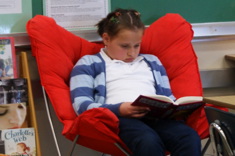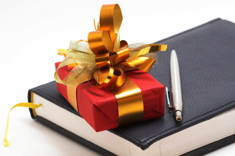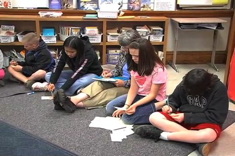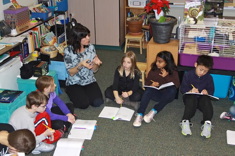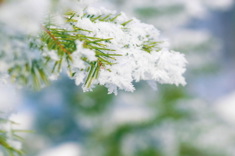Articles
Here is where you’ll find all the latest print features from our contributors. If you’d like to browse specifically by grade level, topic, or contributor, you can use the links in the right sidebar.
Latest Content
Injecting Writing into Everything: Bringing the Outside In
Heather Rader helps a 3rd grade teacher break through the resistance of some student writers. The magic tool? A dirty onion from the garden.
Starting a Newbery Club with Students
If you want to re-energize teen and tween readers in your school, start a Newbery Club. These voluntary groups read, discuss, and take their best guess of which book will win the coveted award in mid-January.
Teaching Blogging to Second Graders
You’re never too young to blog, as Katie DiCesare demonstrates with her 2nd graders.
More Literacy Keepsakes to Carry Home at the End of the School Year
Choice Literacy readers share more of their favorite end-of-year gifts for students to make and take home.
Seedfolks: Connecting Community and Literature
There's so much to do during the first weeks of school, but it's important not to skip the most important thing – building a sense of community with your students.
Draft Stamps: Moving Learners at All Levels Forward
The draft stamp is a simple tool for tracking and accountability, no matter the age of the learner.
Persuasive Pamphlets
Erin Ocon and her middle-school students observe some political activists passing out pamphlets outside the building for a few moments. Voila – the pamphlet project is born. Pamphlets are the perfect genre for teaching persuasion and summary, two key skills highlighted in the Common Core.
5 Easy Steps for Starting a Blog
Mary Lee Hahn and Franki Sibberson share tips for launching and maintaining a blog, as well as a wealth of reasons why it’s a valuable use of your time
Reading Preferences: Social, Pleasurable, and Sometimes Awkward
Karen Terlecky connects an honest appraisal of her reading habits with an unvarnished look at her 5th grade students.
Beginning with the End in Mind: Planning Ahead for Closing Activities
Choice Literacy readers share their favorite end-of-year activities that circle back to events from the start of the school year.
Choosing 5th Grade Read Alouds for the New Year
So many wonderful choices, so little time! Karen Terlecky makes her selections for a year of 5th grade read alouds.
You Never Know What You’re Going To Get
When students help us organize materials, we are often pleasantly surprised at the results.
Pamphlets on Books (Part 2 of the Persuasive Pamphlets Series)
Erin Ocon finds pamphlets are a terrific format for teaching her middle-school students persuasive writing and summary skills. In this essay she explains how to use pamphlets for book recommendations. This is the second installment in a two-part series.
Coaching Beyond the Curriculum: Reframing Our Talk and Attitude Toward Difficult Students
What role should literacy coaches have in helping teachers manage unruly students? Melanie Quinn settles into a morning of poring over assessment data, only to have it interrupted by a child who has been disrupting his class. Her interactions with Darren and his teacher lead to strategies for helping colleagues take an inquiry stance with challenging children.
Closing Out the Library: Cleaning Up and Thinking Ahead
Franki Sibberson provides a series of questions to help you focus on what students need in classroom and school libraries, as well as how those needs might be changing.
Tips for Conducting Demonstration Lessons, or How to Avoid the “Am I Doing This Right?” Question
Clare Landrigan and Tammy Mulligan have advice for teachers and literacy coaches leading demonstration lessons.
Parent Contributions Beyond Instructional Support
Parents want to contribute, but not all contributions are welcome or even helpful when it comes to teaching children how to read and write. Trish Prentice has suggestions for making the most of family skills and willingness to help.
“To Teach is to Learn Twice”: Creating Professional Communities in Schools
What are the hallmarks of professional learning communities that work well in schools?
Helping Children Build Notetaking Skills
Whose job is it to teach notetaking skills? Heather Rader finds teachers often expect colleagues in previous or subsequent grades to teach these skills, as well as a lot of hesitancy about how best to instruct students. She presents a simple notetaking template and describes how she uses it to help students learn how to list important details with words and images.
“What Will You Do with This Mess?”: Helping Students Learn to Collaborate
Sometimes classroom disruptions are rooted in different learning and work styles among children. Andrea Smith finds her attempt to settle a dispute between students about project collaboration helps her face some truths about her own work style.
Keeping “House” in a Literacy-Rich Classroom
Ann Williams has a terrific idea for keeping materials organized in literacy workshops and building student independence at the same time.
Redesigning a Classroom: Putting Students First (and Technology in Its Place)
Mandy Robek faces the challenge of creating a warm and inviting classroom environment that still includes some cold, hard computers for student use.
Using Picture Books to Spice Up Vocabulary Instruction (BOOKLIST)
Picture books are a terrific tool for vocabulary instruction – students have so much fun reading them they are hardly aware of all the new words they are picking up. Franki Sibberson shares her top picks for spicing up vocabulary instruction in this booklist.
Family History Inquiry Project: Integrating Technology with Social Studies in First Grade
Julie Johnson explains how a family history inquiry project in her first-grade classroom built technology, literacy, and research skills as students explored many cultures.
Now is Our Season
Shirl McPhillips so eloquently captures the spirit of the light and dark, hopeful and ambivalent, quiet and purposeful time after the holidays in this poem.
What Velcro Can Do: Science, Literacy and Coaching Connections
No time for science? Don’t like messes? Heather Rader works with a teacher and helps her find a way to fit science neatly into her full teaching day.
Injecting Writing into . . . Everything: Ellipsis Stories
"DOT DOT DOT" – a phrase made famous in Mama Mia, it's also the spark for some writing instruction linked to read alouds from Heather Rader.
From Teacher to Coach: Building Community in the Early Days
The transition from teacher to coach is tricky. Melanie Quinn has advice for building relationships with colleagues in the first weeks of school.
Reorganizing Books in the Reading Support Classroom
Katie DiCesare helps her mom, a reading support teacher, reorganize her materials to better serve students.
Browse Content By
Type
Category
- Assessment Tools
- Big Fresh Archives
- Booklists
- Choice Numeracy
- Classroom Design
- Common Core
- Community Building
- Conferring
- Content Literacy
- Digital Literacy
- English Language Learners
- Equity
- Family Relations
- Free Samples
- Guiding Groups
- Leadership
- Literacy Coaches
- Mentor Texts
- Minilessons
- New Teacher Mentors
- Podcasts
- Poetry
- Quote Collections
- Reading Strategies
- Self Care
- Struggling and Striving Learners
- Talking and Listening
- Teacher Study Groups
- Teaching Reading
- Teaching Writing
- Word Study and Vocabulary
Author
- Melissa Quimby
- Nawal Qarooni
- Gwen Blumberg
- Julie Cox
- The Lead Learners
- Hannah Tills
- Josie Stewart
- Ruth Metcalfe
- Mallory Messenger
- Becca Burk
- Jodie Bailey
- Vivian Chen
- Mary Brower
- Tiffany Abbott Fuller
- Stephanie Affinito
- Ruth Ayres
- Leigh Anne Eck
- Heather Fisher
- Shari Frost
- Julie Johnson
- Suzy Kaback
- Gigi McAllister
- Shirl McPhillips
- Melanie Meehan
- Cathy Mere
- Debbie Miller
- Tara Barnett and Kate Mills
- Tammy Mulligan
- Dana Murphy
- Bitsy Parks
- David Pittman
- Brenda Power
- Heather Rader
- Matt Renwick
- Mandy Robek
- Christy Rush-Levine
- Gretchen Schroeder
- Jen Schwanke
- Brian Sepe
- Katherine Sokolowski
- Stella Villalba
- Jennifer Vincent
Grade Level
Choice Literacy Membership
Articles
Get full access to all Choice Literacy article content
Videos
Get full access to all Choice Literacy video content
Courses
Access Choice Literacy course curriculum and training


